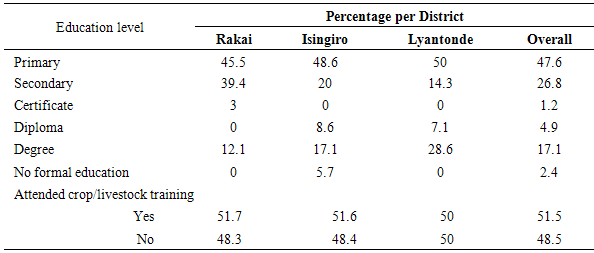-
Paper Information
- Paper Submission
-
Journal Information
- About This Journal
- Editorial Board
- Current Issue
- Archive
- Author Guidelines
- Contact Us
International Journal of Agriculture and Forestry
p-ISSN: 2165-882X e-ISSN: 2165-8846
2015; 5(2): 121-130
doi:10.5923/j.ijaf.20150502.05
Beef Production Practices and Responses to Climate Change in the Rangelands of Lake Victoria Basin in Uganda
Emmanuel Zziwa1, Denis Mpairwe2, Samuel K. Mugasi3, Germana H. Laswai4
1Association for Strengthening Agricultural Research in Eastern and Central Africa, Entebbe, Uganda
2Department of Agricultural Production, Faculty of Agriculture, Makerere University, Kampala, Uganda
3National Agricultural Advisory Services, Kampala, Uganda
4Sokoine University of Agriculture, Morogoro, Tanzania
Correspondence to: Denis Mpairwe, Department of Agricultural Production, Faculty of Agriculture, Makerere University, Kampala, Uganda.
| Email: |  |
Copyright © 2015 Scientific & Academic Publishing. All Rights Reserved.
Rangelands provide the cheapest source of feed for ruminant livestock and account for more than 90% of beef production in Uganda. Rangelands are however being degraded due to changes in resource ownership, management practices, and market forces that exert pressure on rangeland resources. Many farmers are not aware about the existence of alternative feeding practices that can be used to supplement grazing, increase growth rate and returns to investment. This study was therefore conducted to understand the current beef production practices and assess climate variability and change impacts in the beef cattle production systems in the rangelands of Lake Victoria basin. The study was conducted in Rakai, Isingiro and Lyantonde interviewing 33, 37 and 30 cattle producing households. 48.5, 73 and 69.9% of the households in Rakai, Isingiro and Lyantonde District had stayed in the area for more than 20 years with 97.6% of household heads having attained formal education. Average land owned per household was higher in Lyantonde, followed by Isingiro and lowest in Rakai with 738, 364 and 85 acres respectively, with majority of land owned in Lyantonde and Isingiro being under mailo land ownership system while squatter and leasehold systems comprised the majority of land in Rakai. The majority of households, 69.5 and 54.6% in Rakai and Lyantonde Districts respectively were small scale farmers owning 1 – 50 cattle while the majority in Isingiro (39.3%) were large scale farmers owning more than 100 cattle. Pastures were the common feed resource in all districts and most farmers experienced months of feed scarcity every year. The major factors affecting livestock production were parasites and diseases (26.4%), shortage of pasture (13.2%), high prices of drugs and inputs (12.1%), water shortages (11.6%) and drought (9.4%). Farmers perceived climate change in terms of decreases in rainfall and increases in temperatures and frequency of drought. Farmers perceived that climate change is mainly caused by God’s wish, poor farming practices, normal change and ancestral curses. Education level of farmers, land ownership and land size were the major factors affecting farmers’ perceptions on climate change, causes and their adoption of adaptation measures. Farmers with high levels of education, and owning large chunks of land under mailo land systems attributed climate change to poor farming practices and adopted more adaptation measures than their counterparts. Use of crop residues in livestock feeding, improved management of pastures, fencing off grazing areas, water harvesting and stocking rate control were noted to form a plausible climate change adaptation package for agro-pastoral communities.
Keywords: Agro-pastoral, Climate change, Farmers’ perceptions, Grazing systems, Rangeland ecosystem
Cite this paper: Emmanuel Zziwa, Denis Mpairwe, Samuel K. Mugasi, Germana H. Laswai, Beef Production Practices and Responses to Climate Change in the Rangelands of Lake Victoria Basin in Uganda, International Journal of Agriculture and Forestry, Vol. 5 No. 2, 2015, pp. 121-130. doi: 10.5923/j.ijaf.20150502.05.
Article Outline
1. Introduction
- Rangelands cover approximately 50% of the earth’s land surface, 77.4% in Africa [1-3] and 43% of Uganda’s land area [4]. Rangelands are cherished for provision of the cheapest feed resource for ruminant livestock and account for more than 90% of the total ruminant livestock production in Uganda [5]. However, there are substantial variations in physical and structural attributes as well as differences in plant species composition and soil fertility levels in rangelands [1, 6] and these often dictate the appropriate set of management practices that will sustain production without degrading the rangeland. Unlike other land use and cover forms, rangelands are not “natural climax” vegetation types that can persist in absence of human interaction [7]. However, human management practices like livestock grazing, fire, tree cutting may drive unprecedented changes in rangeland ecosystems. Climatic variations and change also cause significant changes in rangeland ecosystem [8-10] and therefore maintenance of rangelands requires strong interactions between human and biophysical drivers [11]. As such, reduction, elimination or over use of rangelands by humans elicits considerable changes in the ecosystem that may either be favourable or unfavourable to the ecosystem and subsequent rangeland utilization and sustainability [12-14]. Grazing animals have both direct and indirect effects on rangeland vegetation with abilities to maintain, degrade, and even rehabilitated the degraded rangeland ecosystem [11, 15, 16]. At a lower stocking density and grazing frequency herbivory may cause little change in a grassland community, but at high density and frequency, it can alter grassland composition, changing it to shrub land or woodland [17]. Livestock production is among the human activities that greatly contribute to global climate change through methane production and expansion of managed grazing systems [18]. Also, feed lot production systems that involve the use of high grain and legume crops concentrations lead to increased methane production through elevated enteric fermentation and manure deposition. On the other hand, expansion of managed grazing lands that involves the conversion of natural systems to pastures contributes a lot of carbon dioxide to the atmosphere through deforestation and desertification [3]. Therefore, there is a need to understand the cattle production systems in rangelands so as to devise appropriate management systems for increased beef production with minimum impact on the rangeland environment and to maintain sustainable production. The objective of this study was therefore to characterize the cattle production and feeding practices and farmers’ perceptions and responses to climate variability and change in the agro-pastoral communities of Lake Victoria Basin in Uganda.
2. Materials and Methods
- Study areaThe study was conducted in Isingiro, Lyantonde and Rakai Districts, which are located in the rangelands around Lake Victoria Basin (Figure 1). Rakai District is located in south-western Uganda between 31°04’ and 32°00’E, and 0°01’ and 1°00’S and receives annual rainfall of 1000 – 1200 mm. It borders Lyantonde District to the northwest, Lwengo District to the north, Masaka District to the northeast, Kalangala District to the east, the Kagera Region in the Republic of Tanzania to the south, Isingiro District to the southwest and Kiruhura District to the northwest. Lyantonde District lies 00°25’S 31°10’E, receives annual rainfall of about 750 - 1000 mm and is bordered by Sembabule District to the north and northeast, Lwengo District to the east, Rakai District to the south, and Kiruhura District to the west Isingiro District is located 00° 50’S, 30° 50’E, receives annual rainfall of between 800 - 1040 mm and is bordered by Kiruhura District to the north, Rakai District to the east, the Republic of Tanzania to the south, Ntungamo District to the west, and Mbarara District to the northwest.
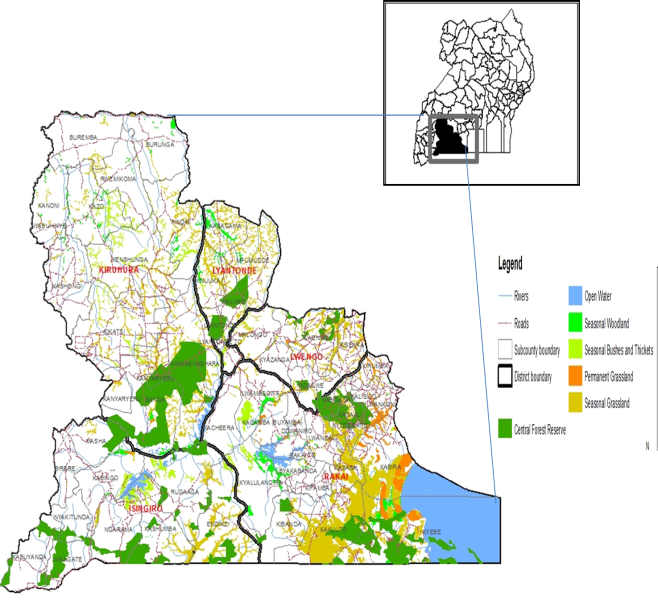 | Figure 1. Map of Uganda showing districts with agro-pastoral systems (rangelands) in the Lake Victoria Basin and the location of Rakai, Isingiro and Lyantonde Districts |
3. Results
- General household information48.5, 73 and 69.9% of the households in Rakai, Isingiro and Lyantonde District had stayed in the area for more than 20 years (Table 1). In Rakai, the majority of households had stayed in the area for between 10 – 19 years (42.4%), 30 – 39 years in Isingiro (24.3%) while there was a uniform spread of household in Lyantonde in the years of 10 – 19, 20 – 29, 30 – 39 and 40 – 49 years. 97.6% of household heads had attended formal education with the majority in all districts having attained primary level education (Table 2). Also, the majority of household heads had ever attended either a crop or livestock training. This was more in Rakai (51.7%), followed by Isingiro (51.6%) and Lyantonde (50%). The primary occupation for household heads in the three districts was livestock herding with 42.9, 36.7 and 50% of household heads in Rakai, Isingiro and Lyantonde Districts respectively (Table 3). All household heads were engaged in cultivation as the second main occupation with 19.5, 33.3 and 33.3% of household heads in Rakai, Isingiro and Lyantonde Districts respectively.
|
|
|
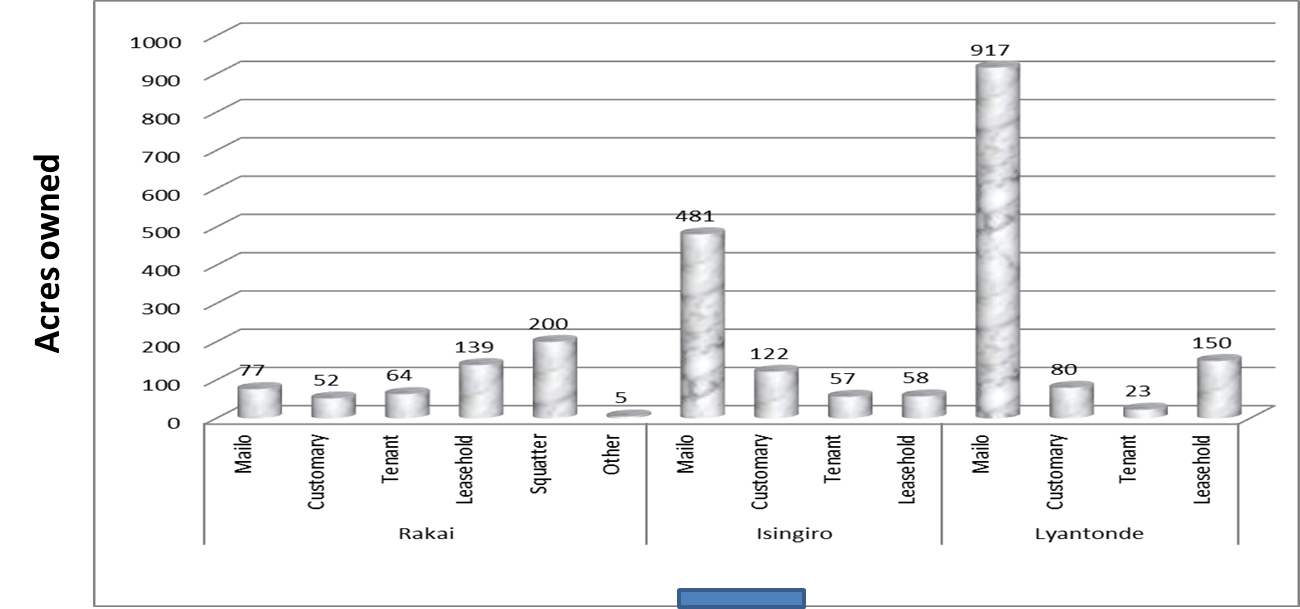 | Figure 2. Average number of acres owned per land ownership category |
|
|
 | Figure 3. Feed resources used in cattle production |
 | Figure 4. Feed availability |
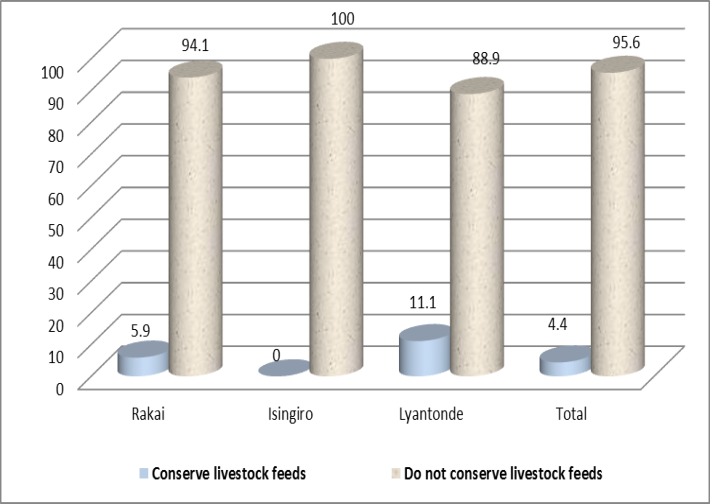 | Figure 5. Percentage of farmers conserving livestock feeds |
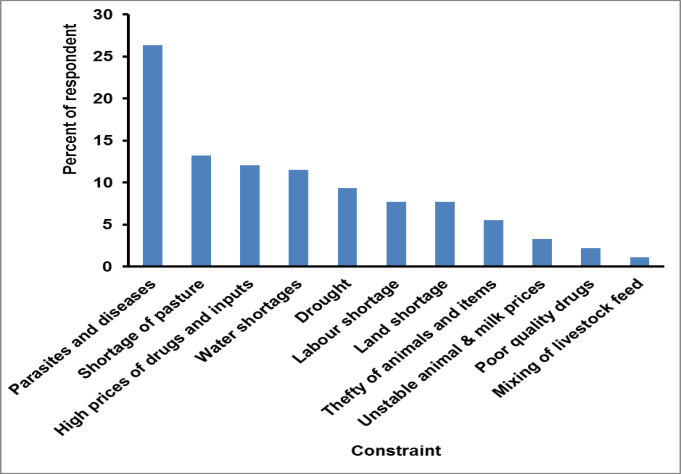 | Figure 6. Constraints to livestock production in Lake Victoria Basin |
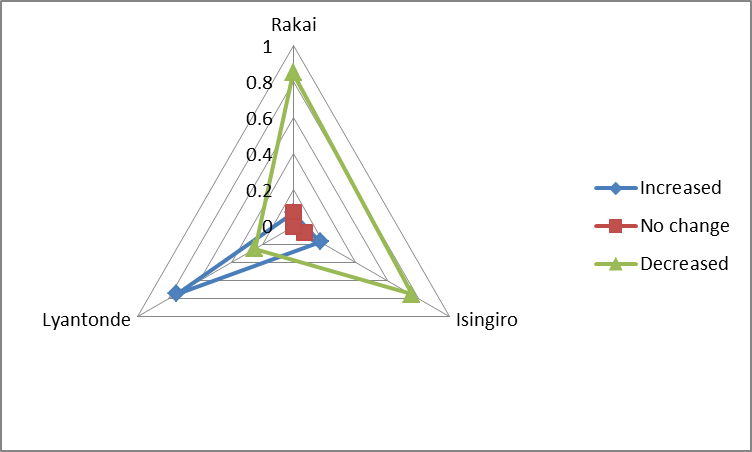 | Figure 7. Perceptions on changes in rainfall |
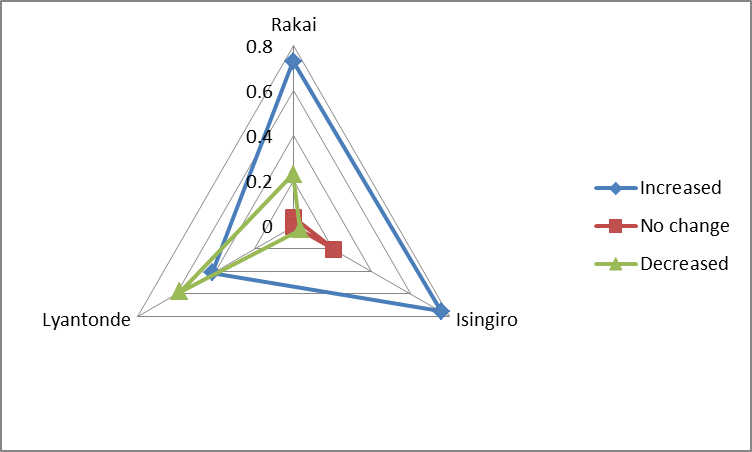 | Figure 8. Perceptions on changes in temperature |
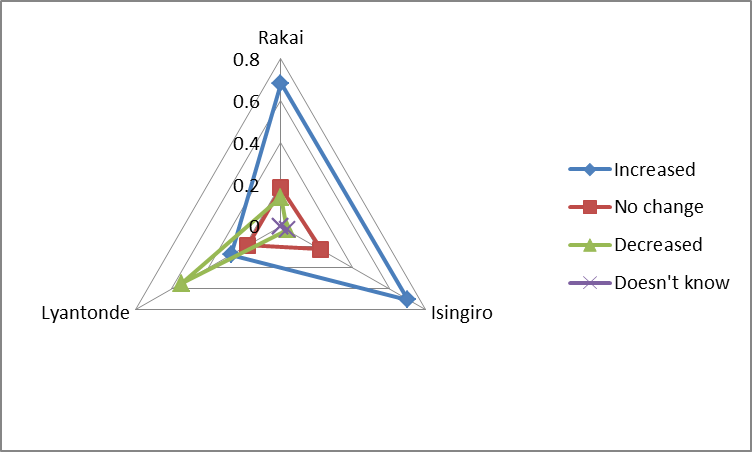 | Figure 9. Perceptions on changes in frequency of drought |
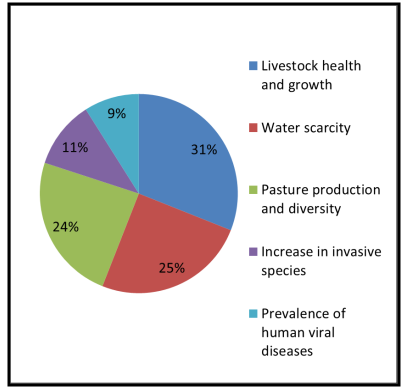 | Figure 10. Impacts of climate change and variability on production |
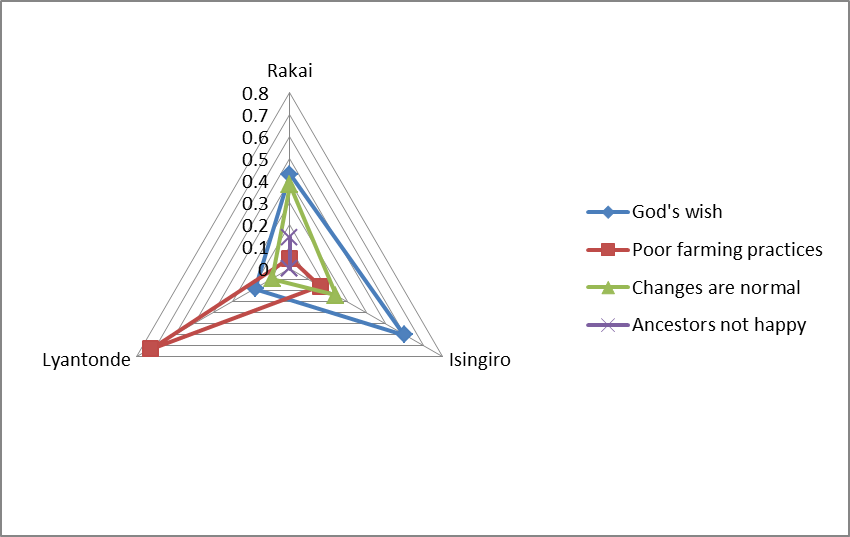 | Figure 11. Farmers’ perceptions on factors contributing to climate change |
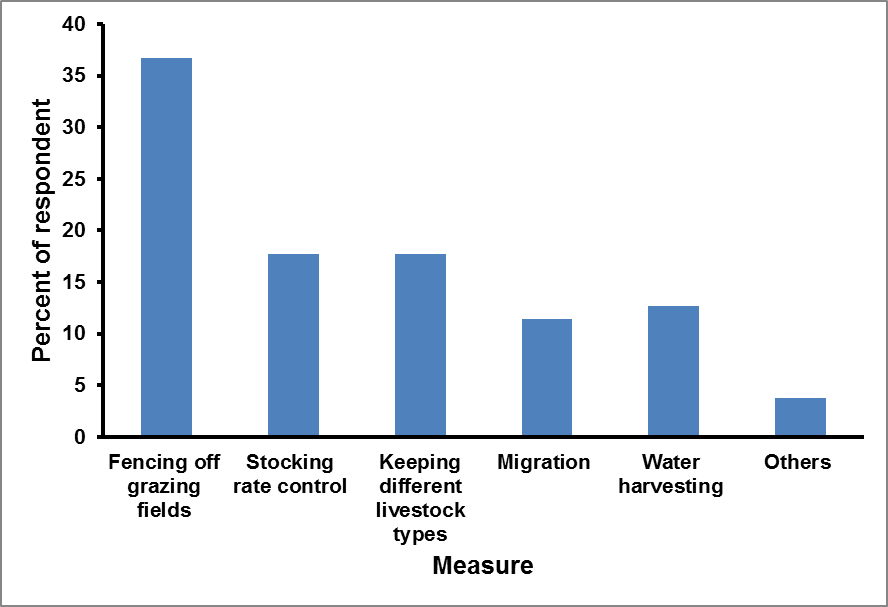 | Figure 12. Adaptation and coping strategies practiced by livestock farmers |
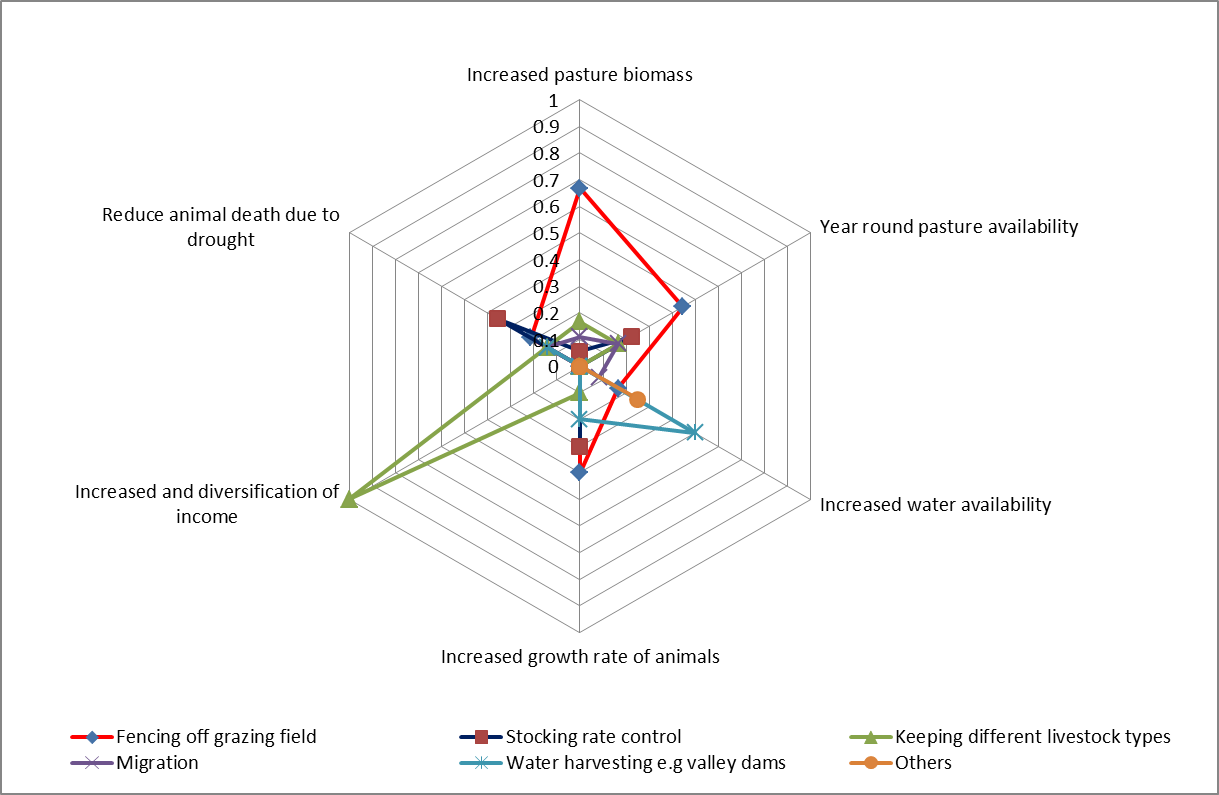 | Figure 13. Benefits accruing from adaptation and coping measures |
4. Discussion
- The number of years a household had stayed in the area had a great bearing on the ability of household members to give an account of long term variations in climate and changes in the quantity, quality and distribution of natural resources in space and time with ability increasing with years spent in the area. Since most of the household heads had attained formal education, there is much likely to be high levels of adoption of agricultural technologies in the three districts since education levels of households have been reported to have strong influence on adoption of agricultural technologies [19, 20]. The results of the study indicated that rangeland production systems in the Lake Victoria Basin of Uganda have shifted from the traditional nomadic pastoralism to settled agro-pastoralism. The changes in production systems may be attributed to shifts in land ownership system from communal to individualized ownership. Average land size and land ownership system influenced number of animals owned per household with households owning more land under mailo land system having more cattle than their counterparts. The differences in prices of cattle and milk in the three districts were attributed to the size of animals and proximity to major towns and cities. In Isingiro, there are more commercial ranches rearing improved beef breeds (Boran) which have a relatively big body size and weight hence the high average price per animal. Lyantonde District is near big towns and cities than either of the two districts and with more developed infrastructure (roads and cooling centers) hence the higher price for milk.The high number of farmers using crop residues in Rakai and Lyantonde than Isingiro is attributed to the fact that the majority of farmers in Rakai and Lyantonde are small scale, making it easy for them to access and transport the residues to their animals. Availability and bulkiness of crop residues are among the factors that limit their utilization in animal feeding [21], as such, farmers with fewer animals can easily access enough and transport them compared to large scale farmers as was the case in Isingiro. Also lack of knowledge in the utilization of crop residues is another major factor limiting their incorporation in animal feeding systems in many parts of the country [21]. As such, the dominance of pastures as a major feed is attributed to availability, access and being cheapest source of feed. Majority of herders in Rakai are squatters and under leasehold land ownership system with access to communal grazing areas and still practice migratory livestock management systems in search for water and pastures. As such, some farmers were not experiencing periods of feed shortage. In Isingiro, there are specialized beef production ranches with well streamlined stocking rate control practices hence the existence of farms where feed scarcity is not experienced. On the contrary, herders Lyantonde are involved in mixed dairy – beef production systems with no access to communal land and with no practical stocking rate control practices. Because dairy animals have higher nutrient requirements than beef animals, feed scarcity is more experienced in Lyantonde than in any other district.Farmers awareness of climate change were consistent with other findings of smallholder farmers in Zambia [22], Kenya [23] and India [24]. The differences in perception of farmers on causes of climate change and adaptation measures employed could be explained by the education levels of farmers. Lyantonde district had the highest proportion of respondents that had attained post secondary education compared to Isingiro and Rakai and this may explain the highest attribution of climate change to poor farming practices and God’s wish respectively. This was consistent with findings in Zambia [22]. The perception of farmers on the causes of climate change was noted to consequently affect their levels of adopting adaptation and mitigation measures with farmers attributing cause to poor farming practices in Lyantonde adapting more than their counterparts who believed in God’s wish in Rakai and Isingiro. These findings were similar to those reported by farmers in USA [25]. Also land holdings and system of ownership affected farmers’ perceptions on climate change and the adaptive practices implemented. Farmers in Rakai with small land holdings and with more squatters and under communal systems were more strongly affected by climate change than their counterparts with large land holdings under individual ownership (mailo land) in Isingiro and Lyantonde districts.
5. Conclusions
- All beef cattle producers in the rangelands around lake Victoria Basin in Uganda are practicing agro-pastoralism with parasites and diseases and drought induced feed and water scarcity being the major challenges limiting production. Although cultivation is becoming an important component, there is limited utilization of crop residues in cattle feeding with lack of knowledge being the major factor limiting their utilization. Great opportunities however exist for inclusion of crop residues in dry season feeding packages. Cattle management practices in drought periods are highly influenced by land ownership and production systems. Migration, the main traditional coping strategy to drought induced feed scaricity is facing extinction due to the many challenges accruing from individualization of land and increased cultivation which blocked livestock migratory routes.
6. Recommendations
- There exist a great potential for utilizing crop residues in feedlot system. This will not only alleviate the pressure on pastures but will also lead to production of more beef with little methane emission as animals will be reaching market weight in a short period of time. Use of feedlot based on crop residues and agro-industrial by products will thus provide an efficient pathway for mitigating methane production and hence mitigating climate change. Improved pasture management such as through fencing off grazing areas, water harvesting and stocking rate control were noted to form a plausible climate change adaptation package for pastoral communities.
ACKNOWLEDGEMENTS
- The authors are grateful to the beef value actors interviewed for their collaboration during the study. District production and agriculture officers in the study districts are also appreciated. The supportive role provided by Makerere University, Department of Agricultural Production staff and students is greatly acknowledged. This study was funded by Lake Victoria Research Initiative (VicRes), through the Inter-University Council for East Africa (IUCEA).
 Abstract
Abstract Reference
Reference Full-Text PDF
Full-Text PDF Full-text HTML
Full-text HTML
